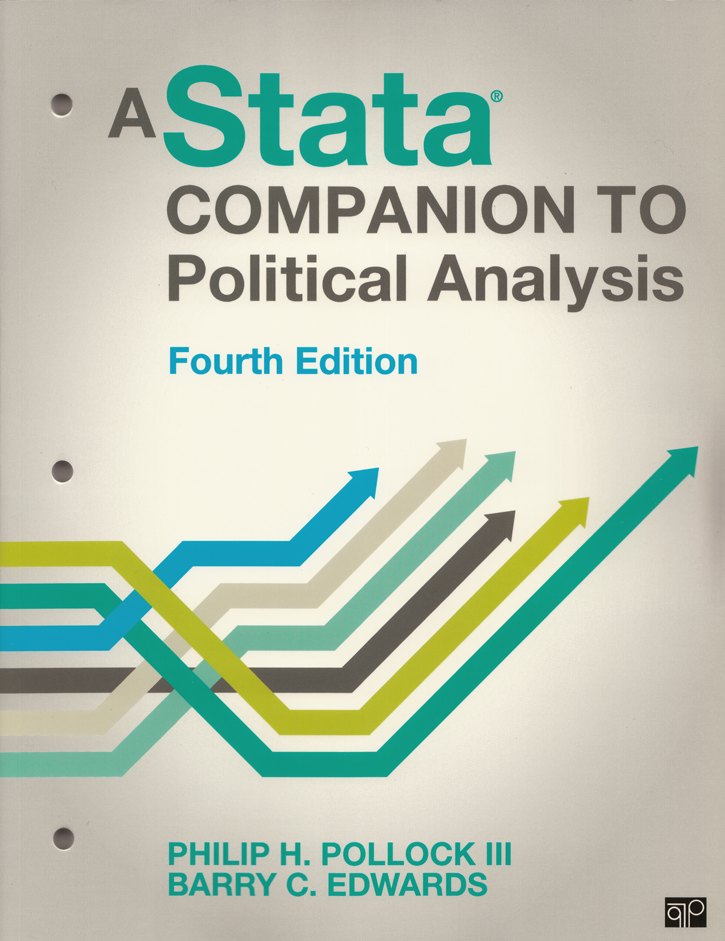The fourth edition of Philip Pollock’s A Stata Companion to Political Analysis is an excellent guide, whether you are taking your first political science course or teaching one. The new edition was updated for Stata 15. Like the previous editions, this book provides instructional insights and focuses on how to present results effectively.
Each chapter is a tutorial with a rich set of exercises. The book surveys the statistical methods that professional political scientists use; its treatment of research methods deftly incorporates data management, graphical analysis, and statistics in the political science domain. In this edition, the authors use Stata’s factor variable notation, which simplifies working with categorical variables and interactions. This complements the authors’ discussion of margins and marginsplot as essential tools to analyze estimation results. The thorough examples show how to complete each task with Stata while giving firsthand experience in political research.
Figures
Preface
Introduction: Getting Started
Datasets
INTRODUCTION TO STATA
Information about a Dataset
Information about Variables
General Syntax of Stata Commands
Do-Files
Printing Results and Copying Output
Log Files
Getting Help
Customizing Your Display
Exercises
DESCRIPTIVE STATISTICS
Interpreting Measures of Central Tendency and Variation
Describing Nominal Variables
A CLOSER LOOK: Weighting the GSS and NES Datasets
Describing Ordinal Variables
Describing Interval Variables
A CLOSER LOOK: Stata’s Graphics Editor
Histograms for Interval Variables
Obtaining Case-Level Information with sort and list
Exercises
TRANSFORMING VARIABLES
Creating Indicator Variables
Working With Variable Labels
Collapsing Variables Into Simplified Categories
Centering or Standardizing a Numeric Variable
Creating an Additive Index
Exercises
MAKING COMPARISONS
Cross-Tabulation Analysis
Visualizing Comparisons With Nominal or Ordinal Dependent Variables
A CLOSER LOOK: The replace Command
Mean Comparison Analysis
A CLOSER LOOK: The format Command
Strip Charts: Graphs for Small N Datasets
Exercises
MAKING CONTROLLED COMPARISONS
Cross-Tabulation Analysis with a Control Variable
A CLOSER LOOK: The If Qualifier
Visualizing Controlled Comparisons With Categorical Dependent Variables
Mean Comparison Analysis with a Control Variable
An Example of an Additive Relationship
Visualized Controlled Mean Comparisons
Exercises
MAKING INFERENCES ABOUT SAMPLE MEANS
Finding the 95 Percent Confidence Interval of a Sample Mean
Testing a Hypothetical Claim About the Population Mean
Testing the Difference between Two Sample Means
A CLOSER LOOK: Inferences About Means with Unweighted Data
Extending the mean and lincom Commands to Other Situations
Making Inferences About Sample Proportions
A CLOSER LOOK: Inferences About Proportions With Unweighted Data
Exercises
CHI-SQUARE AND MASURES OF ASSOCIATION
A CLOSER LOOK: Analyzing Unweighted Data with the tabulate Command
Analyzing an Ordinal-Level Relationship with a Control Variable
Exercises
CORRELATION AND LINEAR REGRESSION
Correlation Analysis
Regression Analysis
A CLOSER LOOK: Treating Census as a Sample
A CLOSER LOOK: R-Squared and Adjusted R-Squared: What’s the Difference?
Creating a Scatterplot with a Linear Prediction Line
Multiple Regression
A CLOSER LOOK: Bubble Plots
Correlation and Regression with Weighted Data
Exercises
DUMMY VARIABLES AND INTERACTION EFFECTS
Regression with Dummy Variables
Interaction Effects in Multiple Regression
Graphing Linear Prediction Lines for Interaction Relationships
Changing the Reference Category
Exercises
LOGISTIC REGRESSION
Thinking About Odds, Logged Odds, and Probabilities
Estimated Logistic Regression Models
Logistic Regression With Multiple Independent Variables
A CLOSER LOOK: Comparing Logistic Regression Models With the estimates Command and the lrtest Command
Graphing Predicted Probabilities With One Independent Variable
Graphing Predicted Probabilities With Multiple Independent Variablees
The margins Command with the over Option
Combining atmeans and over Options
Exercises
DOING YOUR OWN POLITICAL ANALYSIS
Seven Doable Ideas
Self-Interest and Policy Preferences
Economic Performance and Election Outcomes
Electoral Turnout in Comparative Perspective
Interviewer Effects on Public Opinion Surveys
Religion and Politics
Race and Politics
Importing Data into Stata
Microsoft Excel Datasets
HTML Table Data
Writing It Up
Previous Research
Data, Hypotheses, and Analysis
Conclusions and Implications
Table A-2: Variables in the NES Dataset in Alphabetical Order
Table A-3: Variables in the States Dataset by Topic
Table A-4: Variables in the World Dataset by Topic


